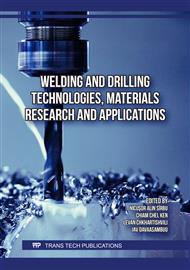[1]
B. Misbah, R. Elgaddafi, R.N. Malhas, S. Al Radhwan, A. Hussain, A. Hersi, Exploring the rheology characteristics of Flowzan and Xanthan polymers in drilling water-based fluids at high-temperature and high-shear rates, Geoenergy Sci. Eng. 2024 (2024) 213309.
DOI: 10.1016/j.geoen.2024.213309
Google Scholar
[2]
S. Davoodi, M. Al-Shargabi, D.A. Wood, V.S. Rukavishnikov, K.M. Minaev, Thermally stable and salt-resistant synthetic polymers as drilling fluid additives for deployment in harsh sub-surface conditions: A review, J. Mol. Liq. 371 (2023) 121117.
DOI: 10.1016/j.molliq.2022.121117
Google Scholar
[3]
S. Davoodi, S.A. Ramazani, V. Rukavishnikov, K. Minaev, Insights into application of acorn shell powder in drilling fluid as environmentally friendly additive: filtration and rheology, Int. J. Environ. Sci. Technol. 18 (2021) 835–848.
DOI: 10.1007/s13762-020-02880-0
Google Scholar
[4]
S. Davoodi, M. Al-Shargabi, D.A. Wood, V.S. Rukavishnikov, K. Minaev, Synthetic polymers: A review of applications in drilling fluids, Pet. Sci. 21 (2024) 475–518.
DOI: 10.1016/j.petsci.2023.08.015
Google Scholar
[5]
S.D. Kulkarni, S. Savari, S. Maghrabi, D.E. Jamison, A. Kumar, Normal stress rheology of drilling fluids and potential in lost circulation control, North Africa Technical Conference and Exhibition, SPE 164617-MS, 2013.
DOI: 10.2118/164617-MS
Google Scholar
[6]
C. Martin, A. Nourian, M. Babaie, G.G. Nasr, Innovative drilling fluid containing sand grafted with a cationic surfactant capable of drilling high pressure and high temperature geothermal and petroleum wells, Geoenergy Sci. Eng. 237 (2024) 212767.
DOI: 10.1016/j.geoen.2024.212767
Google Scholar
[7]
C. Martin, M. Babaie, A. Nourian, G.G. Nasr, Rheological properties of the water-based muds composed of silica nanoparticle under high pressure and high temperature, SPE J. 27 (2022) 2563–2576.
DOI: 10.2118/209786-PA
Google Scholar
[8]
A.A. Aboulrous, M.A. Betiha, H.E.S. Ahmed, W.R. El-Sayed, Improving performance of water-based drilling fluid at elevated temperatures using diatomite/polyacrylamide nanocomposite, Pet. Sci. Technol. 40 (2021) 362–381. https://doi.org/10.1080/10916466. 2021.1996391.
DOI: 10.1080/10916466.2021.1996391
Google Scholar
[9]
M. Batiha, M. Dardir, H. Abuseda, N. Negm, H. Ahmed, Improving the performance of water-based drilling fluid using amino acid-modified graphene oxide nanocomposite as a promising additive, Egypt. J. Chem. 64 (2021) 1799–1806. https://doi.org/10.21608/ejchem .2020.52219.3075.
DOI: 10.21608/ejchem.2020.52219.3075
Google Scholar
[10]
Z. Li, Y. Zhou, L. Qu, H. Li, T. Huang, CBM foam drilling fluid based on hydrophilic silica nanoparticles, Pet. Sci. Technol. 40 (2022) 2639–2658. https://doi.org/10.1080/10916466. 2022.2046608.
DOI: 10.1080/10916466.2022.2046608
Google Scholar
[11]
I. Ali, M. Ahmad, N. Lashari, Improving the performance of bentonite-free water-based mud with lignin-based biopolymer, Pet. Sci. Technol. (2024) 1–13.
DOI: 10.1080/10916466.2024.2326648
Google Scholar
[12]
A.H. Arain, S. Ridha, I. Ali, Development and performance evaluation of castor oil-based biodiesel as an eco-friendly ester-based drilling fluid, Pet. Sci. Technol. 41 (2022) 1831–1851.
DOI: 10.1080/10916466.2022.2097260
Google Scholar
[13]
V. Prakash, N. Sharma, M. Bhattacharya, Feasibility studies of the environment-friendly Grewia optiva fibers as an alternative to the conventional noninvasive fluid additive (NIFA) in water-based drilling fluid, Pet. Sci. Technol. 39 (2020) 133–151.
DOI: 10.1080/10916466.2020.1844230
Google Scholar
[14]
S. Ysbaa, B. Safi, A.N.E.H. Sid, M. Mhadhbi, W. Essafi, Assessing the utilization of sawdust in water-based drilling fluid for managing fluid loss and enhancing viscosity, J. Macromol. Sci. Part B 63 (2024) 1423–1441.
DOI: 10.1080/00222348.2024.2327784
Google Scholar
[15]
J.K.M. William, P. Gupta, J.S. Sangwai, Interaction of lubricants on the rheological and filtration loss properties of water-based drilling fluids, Pet. Sci. Technol. 39 (2021) 235–248.
DOI: 10.1080/10916466.2021.1892757
Google Scholar
[16]
C.D. Adenutsi, J.N. Turkson, L. Wang, G. Zhao, T. Zhang, J.A. Quaye, S. Erzuah, Y.A. Sokama-Neuyam, Review on potential application of saponin-based natural surfactants for green chemical enhanced oil recovery: Perspectives and progresses, Geoenergy Sci. Eng. (2023) 211416.
DOI: 10.1016/j.geoen.2023.211416
Google Scholar
[17]
N. Ridzuan, C.K. Ling, A.S. Tajarazhar, Enhancing water-based mud properties with sodium lignosulfonate polymer and silicon dioxide nanoparticles: A study on interfacial tension and aging behavior, Springer Proc. Mater. 40 (2024) 451–468.
DOI: 10.1007/978-981-99-9848-7_41
Google Scholar
[18]
O.E. Agwu, J.U. Akpabio, M.E. Ekpenyong, U.G. Inyang, D.E. Asuquo, I.J. Eyoh, O.S. Adeoye, A critical review of drilling mud rheological models, J. Pet. Sci. Eng. 203 (2021) 108659.
DOI: 10.1016/j.petrol.2021.108659
Google Scholar
[19]
M.R. Islam, M.E. Hossain, Drilling Engineering, Towards achieving total sustainability, 1st Ed. Elsevier (2020).
Google Scholar
[20]
I. Ali, M. Ahmad, T.A.A. Ganat, Experimental study on water-based mud: Investigate rheological and filtration properties using cupressus cones powder, J. Pet. Explor. Prod. Technol. 12 (2022).
DOI: 10.1007/s13202-022-01471-8
Google Scholar
[21]
J.O. Oseh, N.M.N.A. Mohd, A.O. Gbadamosi, A. Agi, S.O. Blkoor, I. Ismail, K.C. Igwilo, A.I. Igbafe, Polymer nanocomposites application in drilling fluids: A review, Geoenergy Sci. Eng. 222 (2023) 211416.
DOI: 10.1016/j.geoen.2023.211416
Google Scholar
[22]
G. Yazmyradova, N.N.A.A.N.M. Hassan, N.F. Salleh, M. Hermana, H. Soleimani, Reservoir characterisation of high-pressure, high-temperature zone of Malay Basin using seismic inversion and artificial neural network approach, Appl. Sci. 11 (2021) 10248.
DOI: 10.3390/app112110248
Google Scholar
[23]
M.A.A. Alvi, M. Belayneh, S. Bandyopadhyay, M.W. Minde, Effect of Iron Oxide Nanoparticles on the Properties of Water-Based Drilling Fluids, Energies 13 (2020) 6718.
DOI: 10.3390/en13246718
Google Scholar
[24]
F. Alakbari, S. Elkatatny, M.S. Kamal, M. Mahmoud, "Optimizing the Gel Strength of Water-Based Drilling Fluid Using Clays for Drilling Horizontal and Multi-Lateral Wells," presented at the SPE Kingdom of Saudi Arabia Annual Technical Symposium and Exhibition, Dammam, Saudi Arabia, April 2018, Paper Number: SPE-192191-MS.
DOI: 10.2118/192191-MS
Google Scholar
[25]
Alvi, M. A. A., Belayneh, M., Bandyopadhyay, S., & Minde, M. W. (2020). Effect of iron oxide nanoparticles on the properties of water-based drilling fluids. Energies, 13(24), 6718. https://doi.org/10.3390/en13246718.
DOI: 10.2118/192191-MS
Google Scholar
[26]
A.H. Jawad, A.A. Abdulhadi, A.A. Al-Mimar, Enhance the Properties of Lignosulfonate Mud by Adding Nanoparticles of Aluminum Oxide and Iron Oxide, Iraqi Journal of Chemical and Petroleum Engineering 23 (2022) 44–51.
DOI: 10.31699/IJCPE.2022.4.4
Google Scholar
[27]
J. Li, Z. Qiu, H. Zhong, X. Zhao, Z. Liu, W. Weian, Effects of water-based drilling fluid on properties of mud cake and wellbore stability, J. Pet. Sci. Eng. 219 (2022) 109704
DOI: 10.1016/j.petrol.2021.109704
Google Scholar
[28]
R. Taghdimi, B. Kaffashi, M.R. Rasaei, M.S. Dabiri, A. Hemmati-Sarapardeh, Formulating a novel drilling mud using bio-polymers, nanoparticles, and SDS and investigating its rheological behavior, interfacial tension, and formation damage, Sci. Rep. 13 (2023) 12080.
DOI: 10.1038/s41598-023-39257-5
Google Scholar


